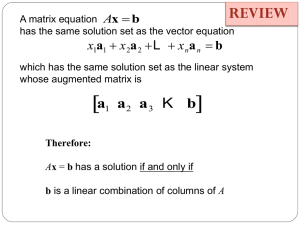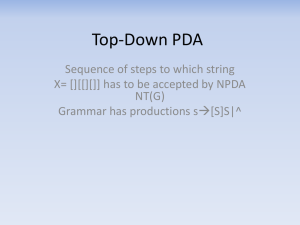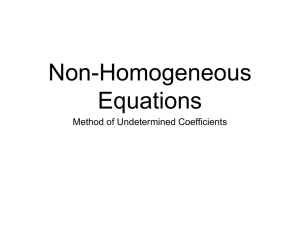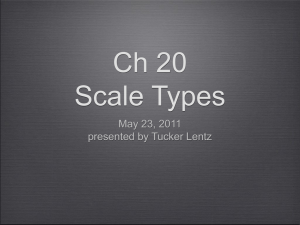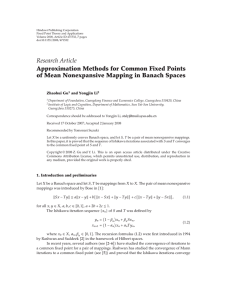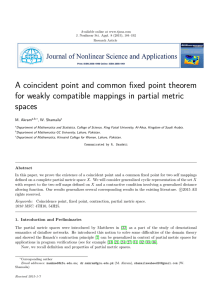Nov. 3
advertisement
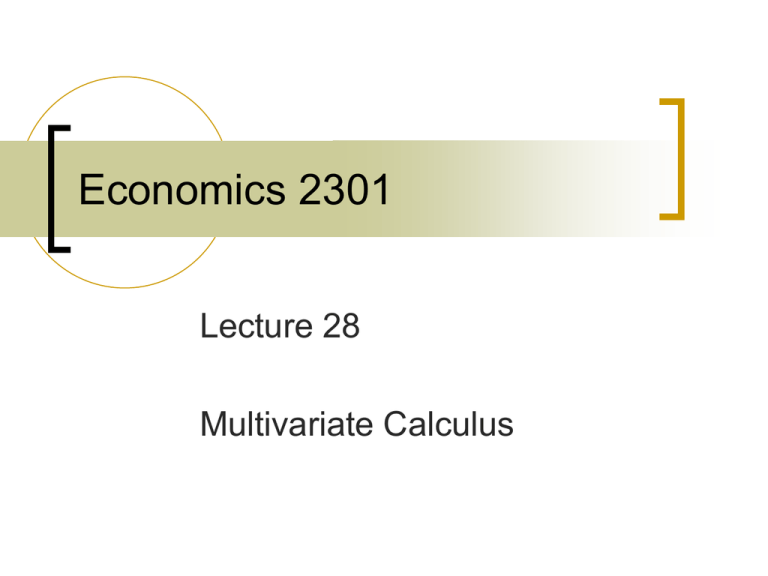
Economics 2301 Lecture 28 Multivariate Calculus Homogeneous Function A function y f(x1,x2 , ,xn ) is homogeneous of degree k if, for any number s where s 0 s k Y f ( sx1 , sx2 ,, sxn ) Cobb-Douglas Function We have theCobb - Douglas P roductionFunction Y K L Increasetheinputsby a factors Y1 δ sK sL s α β δK α Lβ s α βY α β Our Cobb - Douglas functionis homogeneous of degree . If 1, we havedecreasingreturnsto scale. If 1, we haveconstantreturnsto scale. If 1, we haveincreasingreturnsto scale. Euler’s Theorem Homogeneity of degree 1 is often called linear homogeneity. An important property of homogeneous functions is given by Euler’s Theorem. Euler’s Theorem For any multivariat e function y f(x1,x2 , ,xn ) thatis homogeneous of degree k , ky x1 f1(x1,x2 , ,xn ) xn f n(x1,x2 , ,xn ) for any set of values(x1,x2 , ,xn ), where f i(x1,x2 , ,xn ) is thepartialderivativeof thefunction with respect to its ith argument. Proof Euler’s Theorem Definit ionhomogeneous funct ions K y f ( sx1 , sx2 , , sxn ) T aket hepart ialderivat iveof t heabove wit h respect t os ks k 1 y x1 f1 ( sx1 , sx2 , , sxn ) xn f n ( sx1 , sx2 , , sxn ) Let t ings 1, we get Euler's T heorem ky x1 f1 ( x1 , x2 , , xn ) xn f n ( x1 , x2 , , xn ) T heconverseof t his t heoremholds. If t heaboveis t rue, t hen t heoriginalfunct ionis homogeneous of degree k . Division of National Income Suppose that thenationalproductionfunctionis Y K L1 which is homogeneous of degree1, therefore Y Y Y K L K L Now under perfectcompetition, capitaland labor are paid respect ively theirreal returnand real wage. T hisimplies Y wL L 1 K L L 1 Y L Y and rK K K 1 L1 K Y . K Hence, Y rK wL Y 1 Y Properties of Marginal Products For our nat ionalincomeaccountingproductionfunct ion, Y βαK β 1 L1 β which is homogeneous of degree zero. K Likewise for t hemarginalproduct of Labor, Y 1 β αK β L β . Wecan writ ethemarginalproductsas L 1 Y L β 1 1 β βαK L K K and Y K 1 β αK β L β 1 L L Arguments of Functions that are Homogeneous degree zero Any funct ion f(x1,x2 , ,xi , ,xn ) t hatis homogeneous of degree zero can be writ t enas x1 x2 xn f , , ,1, , for any i 1,2,...,n. xi xi xi P roof: Since t hefunct ionis homogeneous of degree 0, s 0 f(x1,x2 , ,xi , ,xn ) f(sx1,sx2 , ,sxi , ,sxn ) Let s 1 , then xi x x x f(x1,x2 , ,xi , ,xn ) f 1 , 2 , ,1, , n xi xi xi QED First Partial Derivatives of Homogeneous Functions If thefunction,f x1 , x2 ,, xn is homogeneous of degree k , theneach of ists first partialderivatives fi f x1 , x2 ,, xn for any i 1,2,, n, is homogeneous xi of degree k-1. Proof of previous slide We know f sx1 , sx2 , , sxn s k f x1 , x2 , , xn f sx1 , sx2 , , sxn f sx1 , sx2 , , sxn d sxi xi sxi dxi sf i sx1 , sx2 , , sxn and s k f x1 , x2 , , xn s k f i x1 , x2 , , xn set t ingt he t wo equal xi sf i sx1 , sx2 , , sxn s k f i x1 , x2 , , xn or f i sx1 , sx2 , , sxn s k 1 f i x1 , x2 , , xn W hichimplies t hederivat iveis homogeneous of degree k-1. Homothetic function A homotheticfunctionis a montonictransformationof a homogeneous functin. T hisif y f(x1,x2 , ,xn ) is a homogeneous function,then z g(y)is a homothetic functionif thefunctiong(y)is strictlymonotonic,that is g'(y) 0 for all y or if g'(y) 0 for all y. Example homothetic function let y x z which is homogeneous of degree . Let w ln (y) ln(x) ln(z ) now ln(sx ) ln(sz ) ln(x) ln(z ) ln(s ) w ln(s) s k w except when are originalfunctionis homogeneous of degree ?. T herefore,while homogeneous functionsare homothetic , not all homotheticfunctionsare homogeneous.

